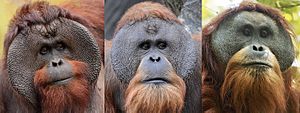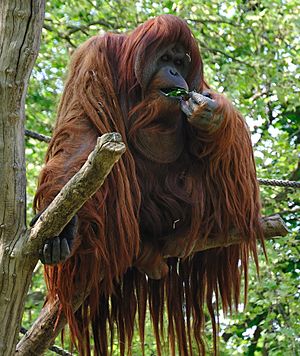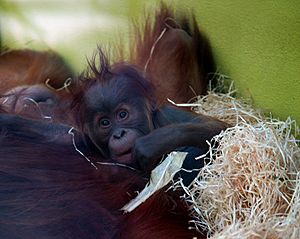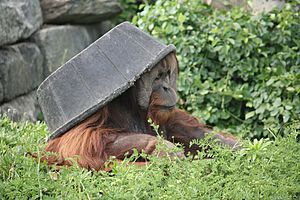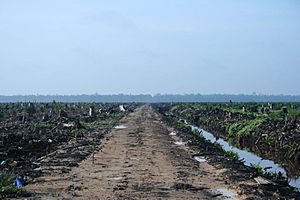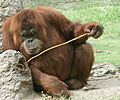Orangutan facts for kids
Quick facts for kids Orangutan |
|
|---|---|
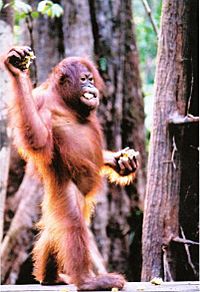 |
|
| Scientific classification | |
| Kingdom: | |
| Phylum: | |
| Class: | |
| Order: | |
| Family: | |
| Subfamily: |
Ponginae
Elliot, 1912
|
| Genus: |
Pongo
|
The orangutan (Pongo) is a type of great ape with reddish-brown fur. There are two main species of orangutan. They originally come from Southeast Asia. Sadly, there are very few orangutans left today. This is because their habitat (the jungle where they live) is shrinking. You can see orangutans at the Singapore Zoo.
The name orangutan comes from two Malay words. Orang means person, and hutan means forest. So, orangutan means person of the forest.
Contents
What Orangutans Look Like
Orangutans have fur that is reddish-brown. They have very long and strong arms. Their hands are also great for climbing trees. The Sumatran Orangutan is a bit smaller. It also has longer hair than the Bornean Orangutan. Orangutans are in danger of extinction because they are losing their forest homes.
Where Orangutans Live and What They Do
Orangutans live in the rainforests. These forests are found on the islands of Borneo and Sumatra in Southeast Asia. They spend most of their lives high up in the trees. They eat fruit, leaves, and bark. They also eat insects, bird eggs, and small vertebrate animals. They drink water that collects on leaves after it rains.
Orangutans are not very comfortable on the ground. They have to push themselves along with their fists. Large adult orangutans move carefully through the trees. They use their flexible feet to hold onto branches. Smaller orangutans can swing through the trees more easily.
What Orangutans Eat
An orangutan's diet is mostly made up of fruit. They especially love ripe fruit. If they cannot find fruit, they will eat bark, leaves, and termites. They prefer to eat these things rather than move to a new place to find food. About 60% of what an orangutan eats is fruit. About 25% is leaves, and 10% is bark and flowers. The remaining 5% is termites and other insects.
Orangutan Life Cycle and Babies
A female orangutan is pregnant for about 230 to 260 days. She usually gives birth to one baby, but sometimes two. This happens every eight to nine years. The young orangutans stay with their mother for many years. They ride on her back and learn how to move through the forest. Just like human babies, young orangutans love to play and are very loving. When they are five or six years old, they start to become more independent. Eventually, they go off to live on their own.
Orangutan Intelligence
Orangutans are known for being very smart. They are among the most intelligent non-human primates. Studies show they can solve some tricky problems. For example, they can figure out where an object is even if they can't see it. At Zoo Atlanta, two Sumatran orangutans even play games on a touch-screen computer!
Tool Use and Learning
Scientists have seen orangutans using tools. The primatologist Birutė Galdikas observed this in orangutans that used to be in captivity. In 1996, researchers also found wild orangutans in Suaq Balimbing using tools. These orangutans had a special set of tools for finding food. They had tools to get insects out of tree hollows. They also had tools to get seeds from hard fruits. The orangutans would change their tools depending on what they needed to do. They often used the tools with their mouths.
Threats to Orangutans
In the early 2000s, orangutan homes quickly disappeared. This was due to trees being cut down and forest fires. Roads also broke up their tropical forest homes. A big reason for this was the clearing of large forest areas. These areas were turned into palm oil plantations. This happened because of the high demand for palm oil around the world. Palm oil is used in cooking, makeup, machines, and even biodiesel.
Hunting orangutans is also a big problem. So is the illegal pet trade, where orangutans are taken from the wild to be sold as pets.
Images for kids
-
Sketch of "The Man of the Woods" by George Edwards, 1758
-
An orangutan at the San Diego Zoo using a tool to get orange juice
-
Orangutan researcher Birutė Galdikas with her book about apes
-
The Female Orang – Utan (Jenny sitting in a chair) from the 1830s
See also
 In Spanish: Orangutanes para niños
In Spanish: Orangutanes para niños



